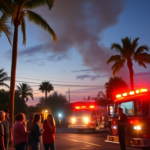I apologize for the incorrect response. Below is the revised news article based on the information provided.
Valley Congressman and Harlingen Mayor Highlight Disaster Declaration and Federal Assistance
As the Rio Grande Valley continues to recover from the devastating March floods, Congressman Vicente Gonzalez and Harlingen Mayor Norma Sepulveda have come forward to discuss the pivotal federal disaster declaration signed by President Donald Trump. This declaration is expected to channel much-needed federal resources into the Valley, facilitating recovery efforts and providing vital assistance to affected families.
Press Conference Outlines Federal Support
In Harlingen, a press conference was held where Congressman Gonzalez and Mayor Sepulveda addressed the key elements of the federal disaster declaration. The primary focus is to deploy federal funds strategically to ensure that the most impacted areas receive prioritized attention and support. This declaration marks a significant step in recovery efforts, emphasizing the pressing need for external aid to help Valley residents rebuild their lives.
Mayor Sepulveda expressed her gratitude for the federal support, saying, “The families in our community have shown immense resilience, but the scope of devastation necessitated federal intervention. We are committed to working closely with federal agencies to ensure swift and efficient distribution of resources to those in need.”
Understanding Local Impact
The federal disaster declaration aims to relieve the pressure on local government bodies that have been stretched thin attempting to manage the aftermath of the floods. This is particularly significant for the Rio Grande Valley, which is often vulnerable to natural disasters due to its geographical location. Recent weather forecasts predict continued evening thunderstorms, compounding concerns for many residents still recovering.
Santiago Morales, a local business owner in Harlingen, shared his perspective on the situation: “While we are used to dealing with severe weather, the flooding this year was particularly harsh. The federal aid will hopefully help businesses like mine bounce back more quickly.”
The influx of federal aid is also expected to bolster infrastructure development, another critical factor in preventing future occurrences of severe flooding. By supporting the upgrading of drainage systems and other flood mitigation measures, long-term stability can be achieved for Valley residents.
Links to Ongoing Community Issues
This declaration further highlights the ongoing challenge of adequately preparing for and mitigating the impact of natural disasters in South Texas. It interconnects with recent legislative initiatives, such as the bill passed by the Texas House to increase oversight of the state’s largest energy users. While the focus of the bill touches primarily on energy consumption and regulation, it underscores the broader need for enhanced infrastructural planning and resilience.
Valley residents have been encouraged to remain engaged and informed about both the immediate aid measures and long-term infrastructural plans. Local outreach programs and community meetings are expected to play an essential role in ensuring transparency and accountability as recovery funds are administered.
Future Community Implications and Perspectives
The reception of federal support introduces both opportunities and challenges, as the community must balance short-term recovery needs with sustainable development goals. There is optimism that effectively utilizing federal resources could lead to improved disaster preparedness infrastructure across the Valley.
However, it is crucial to ensure that the aid reaches all layers of the community, including low-income families and minority groups. Congressman Gonzalez emphasized the importance of equitable distribution: “We are committed to ensuring that every affected resident, particularly those in underserved areas, receives the help they need. This is a chance to not only recover but also build a stronger, more resilient community.”
Resources and Contacts for Valley Residents
Valley residents seeking assistance or detailed information on the federal disaster aid are encouraged to reach out to local government offices or the designated federal assistance hotlines. Additionally, community organizations like the Rio Grande Valley Disaster Recovery Network are pivotal in assisting residents in navigating available resources.
As federal and local agencies work together to deploy aid and implement long-term solutions, the collective efforts of officials, volunteers, and residents highlight South Texas’s resilience and commitment to overcoming adversity. Through coordinated action and community solidarity, the RGV is poised to emerge from this crisis stronger and better prepared for the future.







